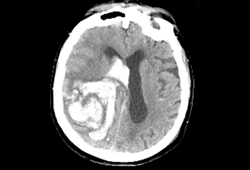Summary
Definition
History and exam
Key diagnostic factors
- neck stiffness
- history of atrial fibrillation
- history of liver disease
- visual changes
- photophobia
- sudden onset followed by progression
- altered sensation
- headache
- weakness
- sensory loss
- aphasia
- dysarthria
- ataxia
- history of hematologic disorder
- vertigo
- nausea/vomiting
- altered level of consciousness/coma
- confusion
- gaze paresis
Risk factors
- hypertension
- advanced age
- male sex
- Asian, black, and/or Hispanic ethnicity
- family history of hemorrhagic stroke
- hemophilia
- cerebral amyloid angiopathy
- sickle cell disease
- autosomal dominant mutations in the COL4A1 gene
- hereditary hemorrhagic telangiectasia
- autosomal dominant mutations in the KRIT1, CCM2, or PDCD10 genes
- anticoagulation
- illicit sympathomimetic drugs
- vascular malformations
- smoking
- nonsteroidal anti-inflammatory drugs (NSAIDs)
- obstructive sleep apnea
- diabetes mellitus
- heavy alcohol abuse
- cerebral vasculitis
- thrombocytopenia
- long sleep duration and poor sleep quality
- Moyamoya disease
- pregnancy
- leukemia
Diagnostic tests
1st tests to order
- noncontrast head CT
- chemistry panel
- CBC
- clotting tests
- ECG
- platelet function test
- urine drug screen
- pregnancy test in women of childbearing age
- liver function test
- intracerebral hemorrhage (ICH) score
Tests to consider
- CT angiography and venography
- magnetic resonance angiography and venography
- conventional (invasive) angiography
- MRI brain
- MRI brain with diffusion-weighted imaging (DWI) and gradient-echo sequence (GRE)
- MRI brain with susceptibility-weighted imaging
Treatment algorithm
Contributors
Authors
Fernando D. Goldenberg, MD
Clinical Associate of Neurology
Medical Director, Neuroscience ICU
Director, Neurocritical Care Education
Co-Director, Stroke Center
University of Chicago
Chicago
IL
Disclosures
FDG declares that he has no competing interests.
Raisa C. Martinez, MD
Neurocritical Care Unit
Department of Neurosciences
Wellstar Health System, Kennestone
Marietta
GA
Disclosures
RCM declares that she has no competing interests.
Acknowledgements
Dr Fernando Goldenberg and Dr Raisa Martinez would like to gratefully acknowledge Dr Alejandro Hornik, Dr Eric E. Smith, and Dr T. Dion Fung, the previous contributors to this topic.
Disclosures
EES is an author of a number of references cited in this topic. AH and TDF declare that they have no competing interests.
Peer reviewers
Louis R. Caplan, MD
Lecturer in Neurology
Hospital Chief
Cerebrovascular/Stroke Division
Beth Israel Deaconess Medical Center
Division of Cerebrovascular/Stroke
Boston
MA
Disclosures
LRC declares that he has no competing interests.
Julien Morier, MD
Neurology Registrar
Neurology Service
Centre Hospitalier Universitaire Vaudois (CHUV)
Lausanne
Switzerland
Disclosures
JM declares that he has no competing interests.
Use of this content is subject to our disclaimer
